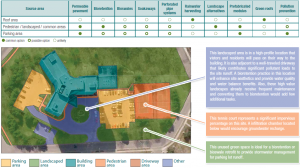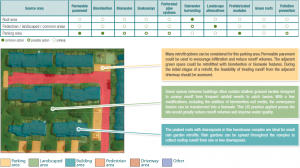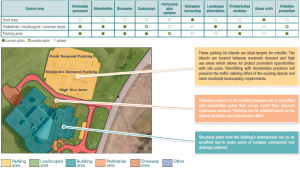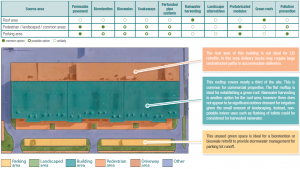Difference between revisions of "LID opportunities in industrial, commercial and multi-residential types"
| Line 1: | Line 1: | ||
| − | The site types considered in this guide are grouped into | + | The site types considered in this guide are grouped into seven general categories based upon site similarities: |
*High and mid-rise | *High and mid-rise | ||
*Low rise | *Low rise | ||
| Line 5: | Line 5: | ||
*Large commercial | *Large commercial | ||
*Small commercial | *Small commercial | ||
| + | *Light industrial | ||
*Institutional | *Institutional | ||
| Line 78: | Line 79: | ||
permeable pavement installations. Bioretention areas may also be located in parking lot areas and are typically enclosed by curbing. Runoff from parking lots can also be directed to LID practices external to the parking lot areas such as perimeter bioswales or soakaways. Infiltration chambers can also be placed under parking lots to provide infiltration or required detention volumes for roof and/or parking areas. Utilities may be buried within parking lots. These are frequently electrical | permeable pavement installations. Bioretention areas may also be located in parking lot areas and are typically enclosed by curbing. Runoff from parking lots can also be directed to LID practices external to the parking lot areas such as perimeter bioswales or soakaways. Infiltration chambers can also be placed under parking lots to provide infiltration or required detention volumes for roof and/or parking areas. Utilities may be buried within parking lots. These are frequently electrical | ||
lines for parking lot lighting. Locates are required before digging occurs. | lines for parking lot lighting. Locates are required before digging occurs. | ||
| + | |||
| + | ==Light industrial sites== | ||
| + | Light industrial sites include light manufacturing, warehouse, warehouse-manufacturing multiuse, laboratories, as well as food production and processing facilities. Common landform features of light industrial sites include fewer than four storeys of building height, maintenance yards, shipping and receiving areas, fl at roofs with internal drainage, and vast but often underused parking lots. | ||
| + | |||
| + | Light industrial sites present unique challenges and opportunities. When evaluating the LID retrofit opportunities on a light industrial site, give preliminary consideration to pollution prevention, especially in and around shipping and receiving areas, and product or waste storage areas. | ||
| + | |||
| + | ===Storage / shipping and receiving=== | ||
| + | Light industrial lands often have storage and/or shipping and receiving areas located immediately adjacent to the building in the front or rear of the property. Due to the intensive use of these areas, they are significant contributors to pollutant loading. | ||
| + | |||
| + | Often, the simplest and most inexpensive way to reduce pollutant loading from these areas is implementing P2 practices. P2 includes non-structural solutions that reduce pollutant loading by changing site practices. For example, reducing the amount of de-icing salts used in the winter can | ||
| + | significantly improve runoff quality. Changing the location of product or waste storage from the perimeter of the site to a controlled catchment area or within the building can also improve runoff quality. Modifying loading and unloading practices by changing equipment or implementing weather | ||
| + | policies can also be extremely effective in reducing the stormwater impact of a site. | ||
| + | |||
| + | Structural P2 practices for these areas could include spill containment structures used to temporarily detain materials or liquids until collection and disposal can occur. Spill containment structures should be part of a site-specific spill response plan. These systems may include subsurface vaults or oversized pipes with shut off valves. Staff training is mandatory for operating these systems. | ||
| + | |||
| + | Outdoor material and waste storage areas can be upgraded with covered storage bins, shelters, or containers to prevent rain from coming into contact with materials that impact stormwater quality. | ||
| + | |||
| + | Establishing buffers around surface conveyance features can also provide significant improvements to runoff quality. These buffers may include physical barriers like bollards or curbs to prevent conveyance features from being used as storage areas. | ||
| + | |||
| + | ===Staff parking areas and rooftops=== | ||
| + | These areas represent the best opportunity for establishing LID practices on light industrial sites. Runoff from these catchment areas can be treated with the same suite of LID options for commercial lands. | ||
Revision as of 18:39, 26 September 2017
The site types considered in this guide are grouped into seven general categories based upon site similarities:
- High and mid-rise
- Low rise
- Light industrial
- Large commercial
- Small commercial
- Light industrial
- Institutional
If the listed site features do not unanimously apply to your site, select the most appropriate category or use a combination of two or more categories to screen LID options. Please note that LID practices are scalable and applying alternate LID practices to those identified for each land use group may be a possibility upon a more detailed evaluation of site constraints (i.e. field testing conducted during pre-design). Choosing an appropriate LID practice can be an iterative process as additional site information becomes available in the predesign phase.
For each land use group, this section identifies source areas typically found on these sites. Source areas are features such as parking lots, roofs, pedestrian areas, common areas, and landscape areas. The section also discusses LID retrofit opportunities and constraints within these source areas, and provides a table for each land use group that identifies common, possible, and unlikely retrofit options.
High-rise and mid-rise sites[edit]
Mid- and high-rise sites (four storeys or more) share common features. These buildings are often for residential use and include apartments or condominiums. They may be operated by residential leasing companies or condominium associations. Many office buildings belong to this site category. Office buildings may be operated by an independent site owner, but they are often owned and operated by commercial land management groups.
Mid- and high-rise buildings have higher user occupancy densities than other sites and therefore require significant parking area. To conserve the site area, these parking areas are typically located underground. Mid- and high-rise buildings most commonly have flat roofs that drain internally to onsite storm sewer networks. These sites typically have common areas, but their size and function vary.
Common areas[edit]
Pedestrian and common areas are outdoor features that can be found on most mid- and high-rise sites. They provide access and egress to buildings and allow pedestrian movement around the property. Most mid- and high-rise buildings will have common areas at their entrance that can include garden features, planters and benches. On residential sites, common areas may include parks or parkettes, playgrounds, sports facilities, sidewalks, and pathways.
Landscaped areas[edit]
Landscaped areas commonly surround mid- and high-rise buildings They can also be found adjacent to parking lots and internal roads. These areas are often grassed and may include plantings. Landscaped areas are ideal for establishing bioretention areas, soakaways, or bioswales where conveyance is preferred. If grading allows, landscaped areas adjacent to the parking lot can easily be retrofitted to provide quality control and water balance benefits. Landscaped areas may also be located within the pedestrian areas adjacent to a building. These areas can be targeted to accept and infiltrate clean roof drainage. Cisterns for rainwater harvesting can also be located in these areas, either buried or above ground. Utilities may be buried within landscaped areas on your site (not just adjacent to the building). Locates are required before digging occurs.
Roof areas[edit]
In most municipalities, the rooftops of mid- and high-rise buildings are not very visible. Developing LID practices on these surfaces will provide benefits but will be more difficult to promote. The exception is major urban centres where a significant number of high rises have been developed and sometimes look onto each other.
Low-rise residential sites[edit]
Low-rise residential sites include townhouses and apartment complexes that are fewer than four storeys. These sites can be operated by property management groups or by condominium boards. Common landform features of low-rise residential sites include small parking lots, and significant pedestrian and landscaped areas. Townhouses have peaked roofs with external drainage while low-rise apartment complexes have flat roofs with internal drainage.
Landscaped areas[edit]
Low-rise residential sites typically have significant landscaped areas. On townhouse sites landscaped areas tend to be spread across the complex as gardens, parking islands, and strips of lawn. Park or community green spaces areas may also be present on these sites. Due to lot grading, it may not be practical to convey road and parking lot runoff to landscaped areas to the building’s perimeter. These areas can, however, be retrofitted to provide water balance benefits by infiltrating roof runoff via bioretention, soakaways, or bioswales.
On sites with larger green spaces LID practices that accept runoff from more substantial catchment areas will likely be feasible. Parks can be retrofitted with most LID options. Subsurface LID options like infiltration chambers can be used without sacrificing park function, while highly visible practices like bioswales or bioretention enhance the aesthetic value.
Parking areas[edit]
Parking areas on low-rise residential properties are often small and well used by residents. Low-rise apartment sites often have parking lots that are graded to catch basins which connect to onsite storm sewers. Due to their smaller, decentralized design, parking areas for townhouse developments typically convey runoff overland to internal roadways equipped with storm sewers.
Permeable pavement is a retrofit option for both types of parking facilities. Internal roadways can also be retrofitted with permeable pavement.
Large commercial sites[edit]
Large commercial sites include big box stores, warehouses, and shopping malls. These sites are often located in highly urbanized commercial centres. They are commonly owned and operated by land management companies.
Large commercial sites are rarely more than two storeys in height. These sites typically have large parking lots that may be underused. Roof areas are often flat and drain internally through the building to onsite storm sewers. Though these sites are expansive, they rarely have complex networks of pedestrian walkways and often rely on vehicular traffic to get site users onsite.
Parking areas[edit]
Not all parking areas are used equally. At large commercial sites parking spots may be reserved for people with disabilities, visitors to the site, expectant mothers, families with young children, specific employees, deliveries, motorcycles, electric cars, taxis and/or public transportation. When considering parking areas for LID retrofit locations, identify and respect these special areas during the design process. The retrofit team should also be aware of how site parking is used throughout the week.
Parking spaces close to building entrances are used more frequently than those in moderate and peak demand areas. If grading and other site-specific factors allow it, the designer may choose to install permeable pavement in the infrequently used areas to extend the life of the system. Conversely, the social benefits of green features may be underappreciated in areas that are not frequented by site users. Developing practices like bioswales or bioretention areas closer to the entrance of the building may be more practical. On many sites existing drainage patterns will dictate where parking lot source controls can be located.
Roof areas[edit]
The roof areas of large commercial buildings account for large impervious surfaces. Controlled roof drains have become a widely utilized tool for stormwater management with the commercial development industry. While these devices do attenuate flows, they do not significantly reduce runoff volumes. By simply directing roof runoff to a soakaway pit, you can provide a great amount of volumetric stormwater control. Consider going one step further and storing this water in a cistern for future use. Commercial rooftops are relatively clean and complex filtration is not required prior to most non-potable uses.
Small commercial sites[edit]
Small commercial sites include strip malls, small private enterprises, car dealerships, and residential sites converted to commercial facilities. While site features can vary significantly with these small sites, typical features include small parking areas and limited pedestrian and common areas. On these sites roof areas can be fl at with internal drainage or peaked with external drainage.
These sites can be owned and operated by the site user, though land management companies also own and operate a significant portfolio of small commercial sites in Ontario.
Landscaped areas[edit]
Landscaped area retrofits on small commercial sites are limited due to high impervious surface coverage. Landscaped areas can often be found near the site perimeter. Where open channel conveyance systems like ditches and swales exist, bioswales are often a suitable retrofit option. Bioretention may also be a suitable option along green site perimeter areas. On many sites, drainage will be conveyed towards site perimeters/away from the building. This allows for the capture of parking lot runoff.
Roof areas[edit]
The roof areas of small commercial buildings account for large impervious surfaces. Whether internal or external roof drains are present, rainwater harvesting is a viable option to achieve water balance benefits. Harvested water can be used for most outdoor uses including irrigation and pressure washing of hard surfaces. Indoor non-potable uses like toilet flushing can most easily be integrated into flat-roof systems with internal roof drainage pipes.
Small commercial building roofs offer excellent opportunities to intercept runoff. Directing roof leaders to bioretention areas, soakaways or even permeable pavement is an option. Alternatively, you could establish a green roof or collect water with a rainwater harvesting system and use it for onsite irrigation or other non-potable uses.
Parking areas[edit]
Like large commercial sites, parking patterns on small commercial sites will include areas of high use that are close to the buildings, as well as areas that are used only during periods of peak demand. Due to lower vehicle speeds and fewer heavy loads, parking lots are ideal locations for permeable pavement installations. Bioretention areas may also be located in parking lot areas and are typically enclosed by curbing. Runoff from parking lots can also be directed to LID practices external to the parking lot areas such as perimeter bioswales or soakaways. Infiltration chambers can also be placed under parking lots to provide infiltration or required detention volumes for roof and/or parking areas. Utilities may be buried within parking lots. These are frequently electrical lines for parking lot lighting. Locates are required before digging occurs.
Light industrial sites[edit]
Light industrial sites include light manufacturing, warehouse, warehouse-manufacturing multiuse, laboratories, as well as food production and processing facilities. Common landform features of light industrial sites include fewer than four storeys of building height, maintenance yards, shipping and receiving areas, fl at roofs with internal drainage, and vast but often underused parking lots.
Light industrial sites present unique challenges and opportunities. When evaluating the LID retrofit opportunities on a light industrial site, give preliminary consideration to pollution prevention, especially in and around shipping and receiving areas, and product or waste storage areas.
Storage / shipping and receiving[edit]
Light industrial lands often have storage and/or shipping and receiving areas located immediately adjacent to the building in the front or rear of the property. Due to the intensive use of these areas, they are significant contributors to pollutant loading.
Often, the simplest and most inexpensive way to reduce pollutant loading from these areas is implementing P2 practices. P2 includes non-structural solutions that reduce pollutant loading by changing site practices. For example, reducing the amount of de-icing salts used in the winter can significantly improve runoff quality. Changing the location of product or waste storage from the perimeter of the site to a controlled catchment area or within the building can also improve runoff quality. Modifying loading and unloading practices by changing equipment or implementing weather policies can also be extremely effective in reducing the stormwater impact of a site.
Structural P2 practices for these areas could include spill containment structures used to temporarily detain materials or liquids until collection and disposal can occur. Spill containment structures should be part of a site-specific spill response plan. These systems may include subsurface vaults or oversized pipes with shut off valves. Staff training is mandatory for operating these systems.
Outdoor material and waste storage areas can be upgraded with covered storage bins, shelters, or containers to prevent rain from coming into contact with materials that impact stormwater quality.
Establishing buffers around surface conveyance features can also provide significant improvements to runoff quality. These buffers may include physical barriers like bollards or curbs to prevent conveyance features from being used as storage areas.
Staff parking areas and rooftops[edit]
These areas represent the best opportunity for establishing LID practices on light industrial sites. Runoff from these catchment areas can be treated with the same suite of LID options for commercial lands.



